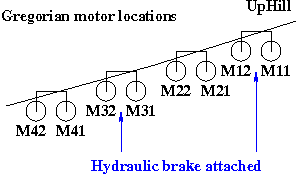dec08
Links:
gr motor names/locations
Gregorian motor torques vs za:
gr motor names/locations
Gregorian motor torques vs za:
- 2013: fitting
torques vs za moving uphill (after hydraulic brake). dome
Weight
- 2002: fit greg torques vs za before hydraulic brake. Dome weight
Motor names/locations (top)
There are 8 Gregorian motors numbered uphill to downhill: 11,12,21,22,31,32,41,42 They are located at:
- Aux mode allows you to disable 1 motor and continue running
- The hydraulic brake slows the dome when it moves downhill.